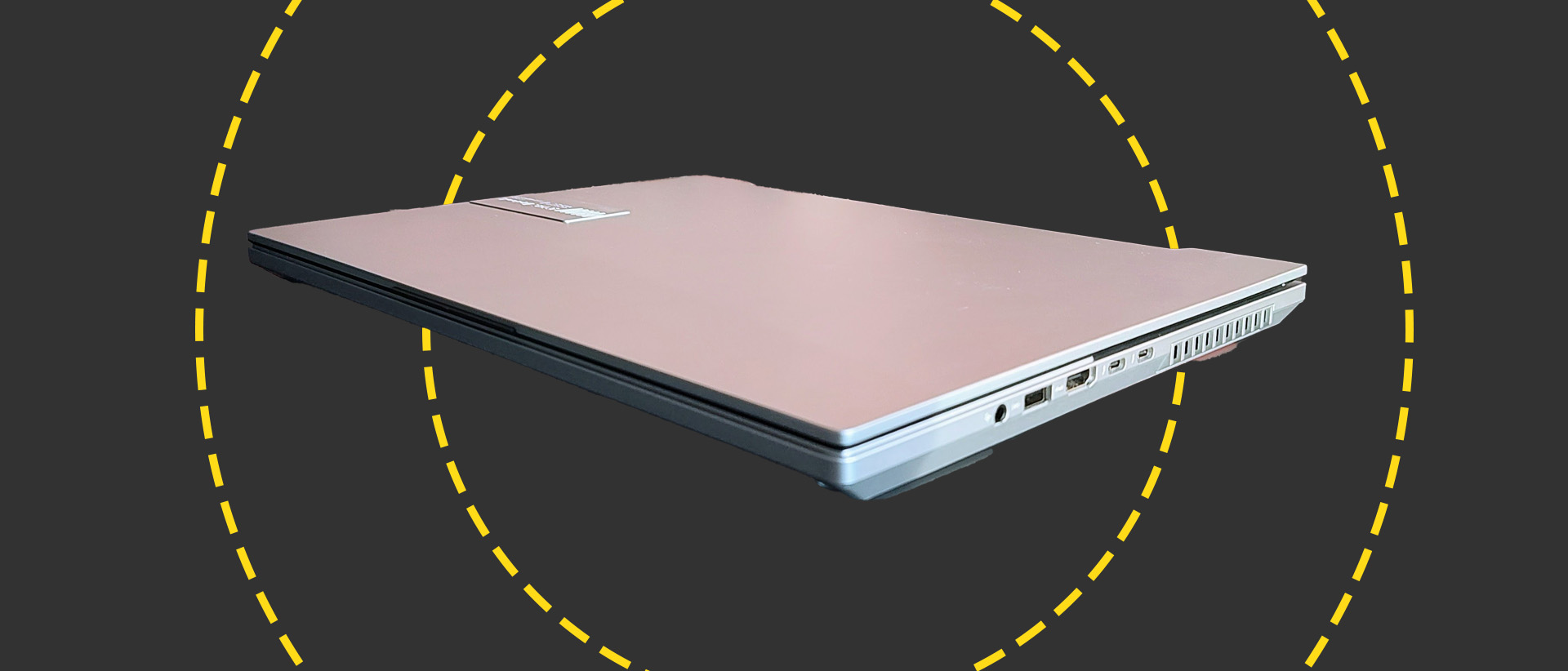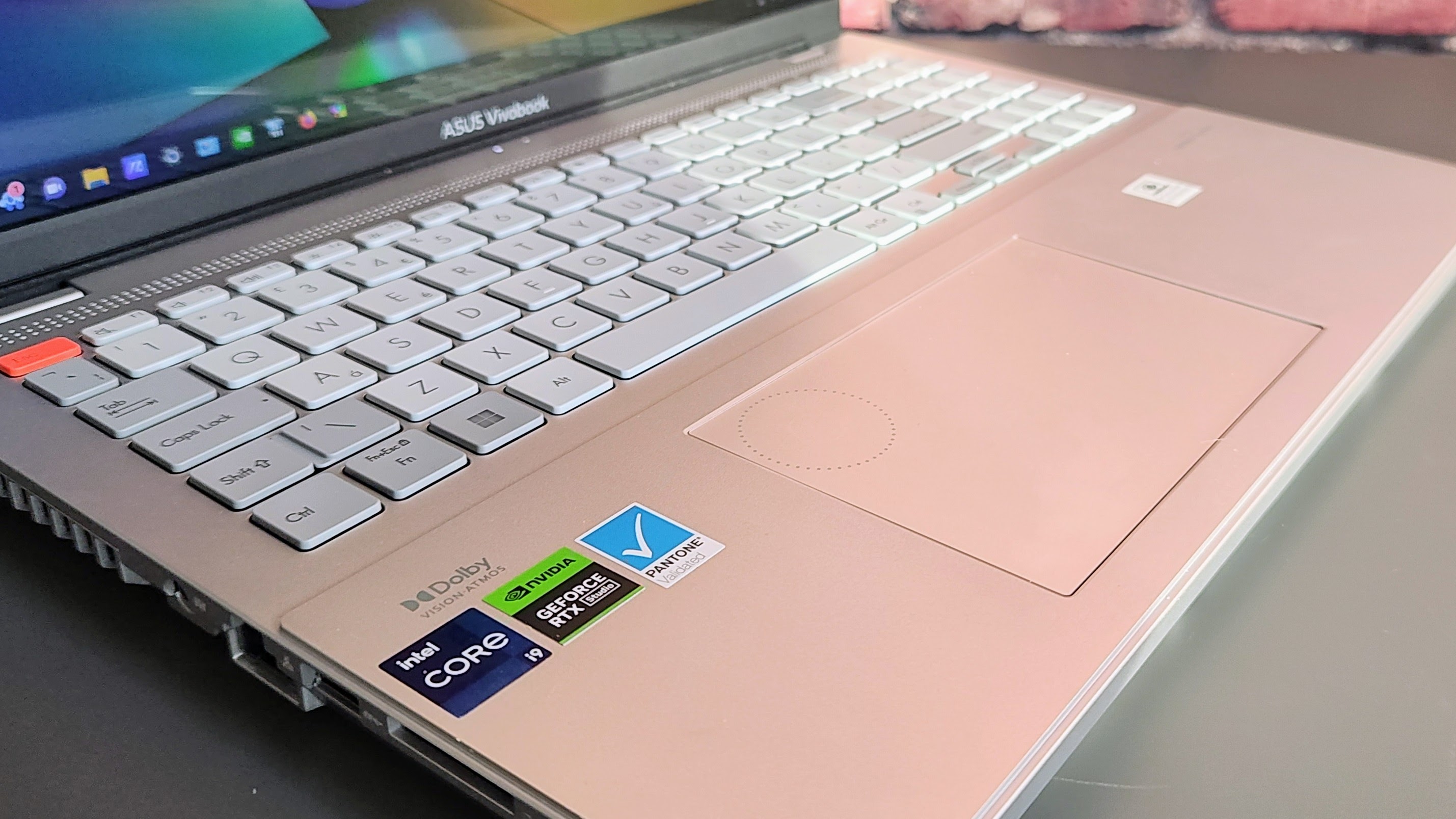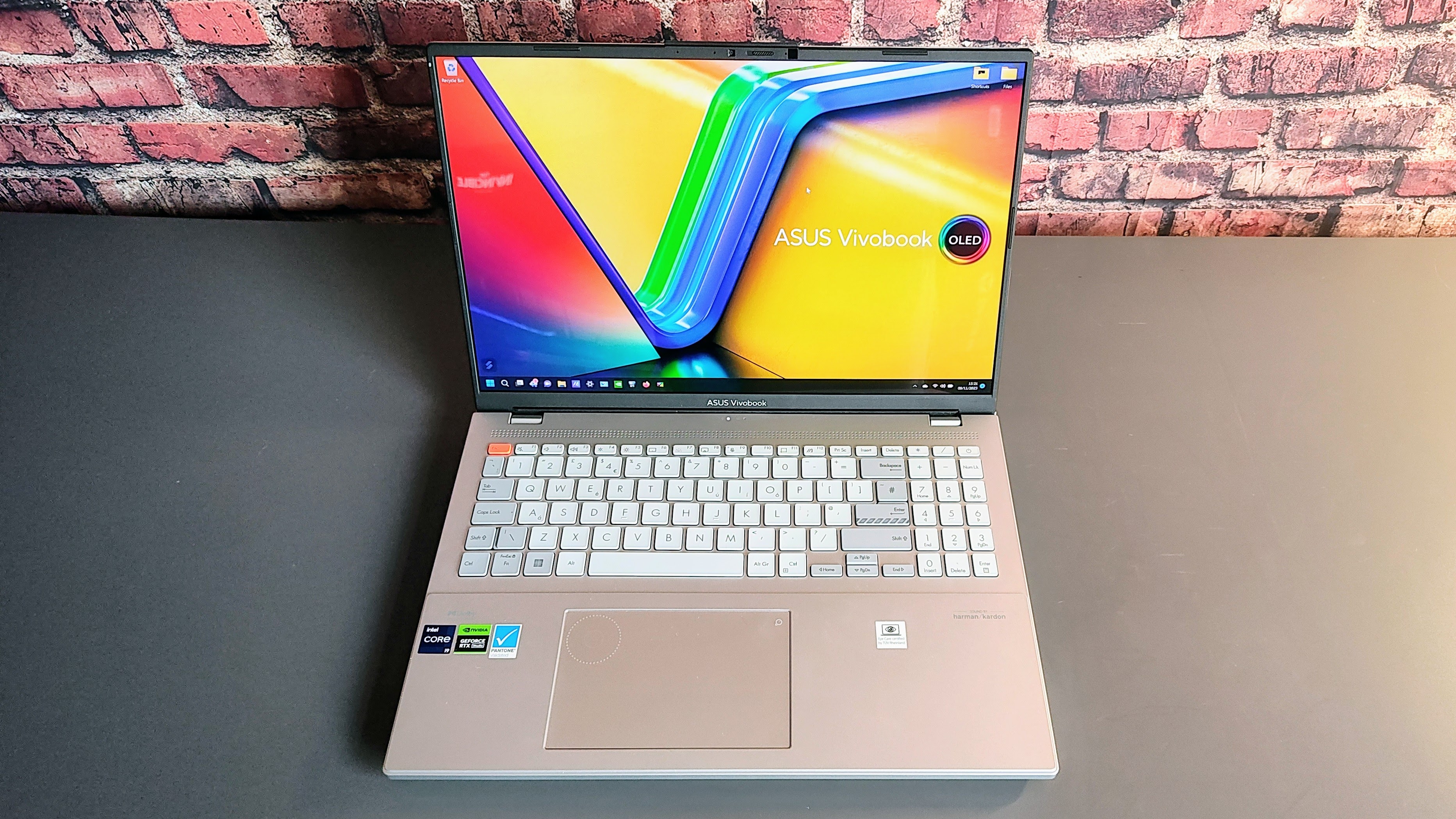ASUS Vivobook Pro 16X OLED (K6604) 2023 review: An extraordinary omnicompetent laptop
If there's a task the new Vivobook Pro 16X can't do well, and quickly, we can't find it – it's a jack-of-all-trades par excellence

-
+
Sumptuous 3.2K OLED display
-
+
Powerful and omnicompetent
-
+
Good value
-
+
Light and compact for a 16-in powerhouse
-
-
Poor battery life
-
-
Slow SSD
-
-
Underwhelming 1080p webcam

Asus's new Vivobook Pro 16X arrives in the market just in time to go head-to-head with Apple's newly updated MacBook 16. That could prove to be either perfect timing or terrible timing. It's terrible if it doesn't prove able to compete with Apple's new wunderkind, perfect if it can, significantly as it undercuts the entry-level M3 MacBook Pro 16 in terms of cost.
As a package, the new Vivobook Pro 16X ticks all the boxes. Pride of place goes to a 120Hz 3,200 x 2,000 OLED screen but buried inside, you will find a 24-core Intel Core i9-13980HX processor with 32GB of RAM, an Nvidia RTX 4070 GPU, a high-capacity 90Wh battery and a spacious 1TB SSD.
ASUS Vivobook Pro 16X: Design
The Vivobook Pro 16X is a somewhat angular affair, much like all the current generation of Vivobook machines. It's a smart, though generic piece of design and is available in two colourways: Cool Silver and Zero Degree Black. For 2023, Asus has made efforts to reduce the weight by incorporating more recycled plastic into the chassis and body, so the new model weighs an impressively low 1.9kg.
The external dimensions of 333 x 249 x 22mm are par for the 16in laptop course and make it narrower than the MacBook Pro but a little thicker. Despite the increased use of plastic, it's a solid laptop, though the aluminum lid is a little more wobbly than I'd have liked. Like many Asus laptops, it meets the US MIL-STD 810H military-grade standard for resistance to shock, temperature, and particle ingress.
On the right side of the Vivobook Pro 16X, you'll find two Thunderbolt 4 ports, an HDMI 2.1 video output that can support 8K/60Hz video, a USB-A 3.2 Gen 1 data port, and a 3.5mm audio port. On the left are a second USB-A port, the DC jack for the 230W power brick, a gigabit RJ-45 port, and an SD card slot.

The eagle-eyed amongst you will have noticed that the second Thunderbolt port is new for 2023, as is the SD card slot, with the 2022 model having a less useful (certainly for professional photographers) MicroSD card receptacle.
Removing the base is a straightforward affair, and once inside, you can access the wireless card, both SODIMM RAM mounts, and the SSD bay, though sadly, there isn't space for a second SSD. Our test machine's 1TB Solidigm SSD returned poor sequential read and write speeds of 3,365MB/s and 2,042MB/s, respectively. We've seen MacBook Pro's return double those speeds. The wireless card is an Intel AX211 component that supports 6Ghz Wi-Fi and Bluetooth 5.3.
Sign up today and you will receive a free copy of our Future Focus 2025 report - the leading guidance on AI, cybersecurity and other IT challenges as per 700+ senior executives
ASUS Vivobook Pro 16X: Keyboard, touchpad, and webcam
The two-tone grey keyboard is easy on the eye, and the distinction between the dark grey enter keys, light grey alphanumeric keys, bright red escape key and the twill-pattern on the Enter key isn't entirely a matter of aesthetics. We found it improved our focus on the central part of the keyboard when typing. The keys have 1.4mm of travel and a clean action with a positive end stop. The action is entirely silent.
Behind the keys is a three-level white backlight, which we suspect works better with the darker keys of the black model than the grey keys of our silver model, but that's more a matter of personal taste.

The trackpad is a spacious 130 x 85mm affair with a smooth surface and firm, positive corner click-action. Swipe in from the top right corner, and the Asus DialPad comes to life. Spin your finger around this, and you can adjust system settings like the volume or brightness and now also set it to adjust anything that you can assign a Windows keyboard shortcut to.
Though initially intended to work closely with Adobe's creative apps, the DialPad has evolved into a more broadly helpful feature on Asus' creative laptops. The DialPad is managed via Asus' ProArt Creative Hub software, which comes preloaded, though you have to download the DialPad CP plug-in from the Microsoft Store. Once set up, you can use the DialPad for all manner of shortcuts, like zooming in and out of your web browser or controlling the Spotify app.
For a premium laptop, the webcam is a little underwhelming. Granted, it can record video at 1080p and 30fps but images look grainy even in well-lit environments. It's no match for the MacBook Pro's webcam and should be better for the money. The webcam doesn't support Windows Hello facial recognition, so you are limited to the one-hit fingerprint scanner built into the power button for biometric security. At least the camera has a physical security shutter.
Next to the camera array is a sensor that detects ambient light levels so the system can adjust the brightness of the display and keyboard backlight to best suit your environment.
ASUS Vivobook Pro 16X: Display
The display is a very impressive 16-inch, 120Hz OLED affair. It's as good as any OLED screen available on any laptop. The 3,200 x 2,000-pixel panel isn't quite as sharp as the MacBook Pros at 235dpi to 254dpi, but the difference is beyond the human eye to discern. It's bright, too, hitting 385cd/m2 in SDR mode and 605cd/m2 in HDR mode, earning it a Vesa DisplayHDR True Black 600 certificate.
There is color aplenty thanks to some large gamut volumes of 147% sRGB, 104.2% DCI-P3, and 101.3 Adobe RGB, all validated by Pantone. The display is also superbly accurate, with Delta E variances of just 0.76 vs the sRGB profile with the sRGB clamp on and 0.81 vs the DisplayP3 profile with the screen in the respective color mode. Those results are outstandingly good.
HDR performance is hugely impressive, with infinite contrast and superbly saturated colors. Whether you are just watching video gaming or creating HDR content, the Vivobook Pro 16X's display is a joy to behold, even if it can't match the searing brightness of the MacBook Pro's Mini LED display.

Asus claims a 0.2ms response time for the screen. While we're not sure about that –G2G response times are like electric car ranges, to be taken with more than a pinch of salt – motion fidelity is excellent, with hardly any discernible ghosting or smearing. Gaming and 3D modeling animations look superb on the Vivobook.
ASUS Vivobook Pro 16X: Specs and performance
The Vivobook Pro 16X goes like the devil himself is chasing it, thanks to the Nvidia GPU having a TGP of 140W rather than being tuned down as you often find in "creative" laptops and a MUX switch to help extract the maximum frame rate.
READ MORE

In our standard 4K multi-media benchmark, the Vivobook scored 587 points, which is an excellent score and one only significantly bettered by the latest generation of fire-breathing uber-gaming laptops from Asus ROG and Alienware.
For comparison, the Vivobook Pro 16X's little brother, the Asus Zenbook Pro 14, a laptop that is hardly lacking on the performance front, scored 461. The difference is down to the extra 10 CPU cores the Pro 16X has (2 Performance, 8 Efficiency) and the higher TGP setting on the RTX 4070 GPU. The M2 Pro MacBook Pro scored 418 points. I'll be interested to see how much the new M3 chipset closes that gap when we get the new MacBook Pro in to test.
The Cinebench R23 multi-core score of 25,669 and the PCMark 10 score of 8,239 put the Vivobook Pro 16X comfortably inside the top decile of laptops we've tested at ITPro.
Graphics performance is equally impressive, with the Vivobook running the SPECviewperf 3Dsmax-07 3D modeling test at 96fs and scoring 12,060 in the 3DMark Time Spy benchmark. The Vivobook Pro X16 won't disappoint if you fancy heavyweight gaming. It managed to run Cyberpunk 2077 at FulllHD and with raytracing at 60fs. Forgo ray tracing, and that number will jump to 98fs.
Despite its impressive level of performance, the Vivobook Pro 16X keeps its cool. When running the FurMark GPU stress test, the GPU temperature peaked at 82°C, but the external casing never became more than warm to the touch with external temperatures peaking at 38℃ in the center of the keyboard deck. Fan noise peaked at 67dB(A) which is acceptable for a laptop running on such high-power components.

Battery life is the Vivobook Pro 16X's Achilles' heel. Run the Nvidia GPU hard (on battery power, it won't exceed 67% TGP), and the 90Wh battery will drain in around one hour. In our usual battery rundown test using VLC to loop an SD video with the display set to 170cdm/2, the battery lasted for 3 hours 15 minutes, an improvement but still a poor showing considering the battery capacity. As always, Apple rules the roost regarding battery life, but that's irrelevant if, like me, you don't spend much time away from a power socket.
ASUS Vivobook Pro 16X: Is it worth it?
The Vivobook Pro 16X is available in two versions. One with a 165Hz 2,560 x 1,600 IPS screen an Intel Core i7-1365HX CPU, and the Core i9 OLED model we have on test. The Core i7 model is generally on sale for around £2,000, but some retailers have the OLED machine on sale for the same price, which makes it an absolute steal.
The new M3 MacBook Pro 16 has a starting price of £2,599, but you only get 18GB of combined RAM and 512GB of storage compared to Asus's 32GB of system RAM, 8GB of vRAM, and a 1TB SSD. If you up the MacBook Pro's spec to that of the Vivobook, you are looking at a final bill of £3,200, a considerable premium for a laptop whose advantages are limited to much superior battery life, faster storage, and a better webcam.
Compared to the 2022 Vivobook Pro 16X, Asus has made some worthwhile upgrades beyond the next-gen CPU and GPU such as the addition of a MUX switch, an extra Thunderbolt 4 port, and moving from a MicroSD to an SD card slot. Given the Vivobook Pro 16X's level of performance and extraordinary omnicompetence, it's hard not to describe it as excellent value, especially when you can pick up the OLED model for the same price as the IPS version.
ASUS Vivobook Pro 16X specifications
| Display | 16-inch 3,200 x 2,000 OLED, 16:10 aspect ratio, 120Hz refresh rate, 385cd/m2 brightness (SDR), 605cd/m2 (HDR) |
| Processor | Intel Core i9-13980HX |
| GPU | Nvidia RTX 4070 |
| RAM | 32GB DDR5 |
| Ports | Thunderbolt 4 x 2, USB-A 3.2 Gen 1 x 2, HDMI 2.1 x 1, Gigabit RJ-45 x 1 |
| 3.5mm audio jack | Yes |
| Camera | Camera 1080p webcam with privacy shutter |
| Storage | 1TB PCIe 4 SSD |
| Connectivity | Wi-Fi 6E (802.11ax), Bluetooth v5.3 |
| Weight | 1.9Kg |
| Dimensions | 333 x 249 x 22mm |
| Battery Capacity | 90Wh |
| Operating System | Windows 11 Home |
Over the years, Alun has written freelance for several online publications on subjects ranging from mobile phones to digital audio equipment and PCs and from electric cars to industrial heritage. Before becoming a technology writer, he worked at Sony Music for 15 years. Quite what either occupation has to do with the degree in Early Medieval History he read at the University of Leeds is a bit of a grey area. A native of Scotland but an adopted Mancunian, Alun divides his time between writing, listening to live music, dreaming of the glens and dealing with an unhinged Norwegian Elkhound. For ITPro, Alun reviews laptops and PCs from brands such as Acer, Asus, Lenovo, Dell and HP.
-
 Gender diversity improvements could be the key to tackling the UK's AI skills shortage
Gender diversity improvements could be the key to tackling the UK's AI skills shortageNews Encouraging more women to pursue tech careers could plug huge gaps in the AI workforce
By Ross Kelly Published
-
 Researchers claim Salt Typhoon masterminds learned their trade at Cisco Network Academy
Researchers claim Salt Typhoon masterminds learned their trade at Cisco Network AcademyNews The Salt Typhoon hacker group has targeted telecoms operators and US National Guard networks in recent years
By Emma Woollacott Published
-
 HPE says unified channel strategy won't force Juniper partners to generalize
HPE says unified channel strategy won't force Juniper partners to generalizeNews Does the company embrace specialists or want a full portfolio push? The answer, it seems, is both
By Jane McCallion Published
